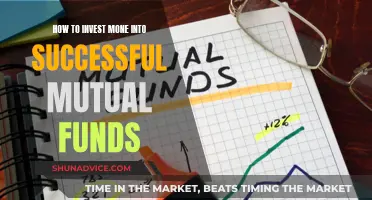
Index funds are a popular investment option in Australia, offering a low-cost, diversified way to invest in a range of stocks or asset classes with a single purchase. They are considered a form of passive investing, where fund managers aim to replicate the returns of a specific index on a stock exchange, rather than actively picking individual stocks.
In Australia, Exchange-Traded Funds (ETFs) are the most common type of index fund and can be traded on the Australian Securities Exchange (ASX) like ordinary shares. When investing in an ETF, individuals own units in the fund, while the ETF provider owns the underlying shares or assets.
Some popular index funds in Australia include:
- Vanguard Australian Shares Index ETF (ASX: VAS)
- iShares Core S&P/ASX 200 ETF (IOZ)
- SPDR S&P/ASX 200 (STW)
- BetaShares NASDAQ 100 ETF (NDQ)
- iShares S&P 500 ETF (IVV)
What You'll Learn

Exchange-traded funds (ETFs)
When you invest in an ETF, you don't own the underlying investments. Instead, you own units in the ETF, and the ETF provider owns the shares or assets. ETF units can be created or redeemed to match investor demand, helping the unit price stay close to the net asset value (NAV) of the ETF.
In Australia, most ETFs are passive investments that don't try to outperform the market. The fund manager of a passive investment tracks the value of an index, for example, the ASX200 or S&P500, or a specific commodity such as gold. The value of the ETF then goes up or down with the index or asset it is tracking.
ETFs can be either physically-backed or synthetic. A physically-backed ETF invests in all the securities in the index or a sample of the securities in the index. A synthetic ETF holds some of the underlying assets and uses derivatives to copy the movements of an index or asset.
ETFs are available for a range of asset classes and individual assets, including international shares, sectors of the Australian or international share market, fixed-income investments like bonds, precious metals and commodities, and more.
There are several benefits to investing in ETFs, including:
- Diversification: ETFs allow you to buy a basket of shares or assets in a single trade, helping to diversify within an asset class.
- Transparency: ETFs publish the net asset value (NAV) daily, helping you track how the underlying assets are performing and if the price of the ETF is close to the NAV.
- Low cost: ETFs typically have a low management expense ratio (MER) and are usually cheaper than equivalent managed funds.
- Easy to trade: You can buy and sell ETFs during the trading hours of the exchange, through a broker, and you can typically buy smaller quantities of ETF units than unlisted managed funds.
However, there are also some potential drawbacks to investing in ETFs, including:
- Market or sector risk: If the market or sector the ETF is tracking falls in value, so will the value of your ETF investment.
- Currency risk: If the ETF invests in international assets, you face the risk of currency movements impacting your returns.
- Liquidity risk: Some ETFs invest in assets that are not liquid, such as emerging market debt, which can make it difficult for the ETF provider to create or redeem securities.
- Tracking errors: An ETF's return may differ from the index or asset it is designed to track due to differences in the assets owned, fees, taxes and other factors.
When deciding whether to invest in ETFs, it is important to consider your financial goals, risk tolerance and investment time frame. It is also crucial to research different ETFs and compare their management fees, other fees, investment minimums and performance.
Some popular ETFs in Australia include:
- Vanguard Australian Shares Index ETF (ASX: VAS)
- IShares Core S&P/ASX 200 ETF (IOZ)
- SPDR S&P/ASX 200 (ASX: STW)
- IShares S&P 500 ETF AUD (ASX: IVV)
- BetaShares NASDAQ 100 ETF (ASX: NDQ)
- Vanguard MSCI Index International Shares ETF (VGS)
Cion REIT: A Smart Investment Fund Move?
You may want to see also

Managed funds/mutual funds
Managed funds or mutual funds are a type of index fund that is traded off-market through fund issuers at prices they set daily. They generally don't attract a fee for buying or selling units in the fund and typically require a higher minimum investment with higher management fees.
When you invest in a managed fund, you're pooling your money with other investors, and this collective fund is managed by a fund manager. You will own units in the fund but not the underlying securities. The fund manager holds and controls the money on your behalf.
Managed funds can be listed (traded on the share market) or unlisted (bought and sold directly through the fund manager). Listed funds are valued daily according to their price on the relevant stock exchange, while unlisted funds are usually valued less frequently, based on the value of the underlying assets held by the fund.
A managed fund can be invested in various areas on your behalf, such as cash, shares, bonds, listed property trusts, or other securities. The value of the units may rise and fall with the value of the underlying assets in the managed fund, and some also pay income or distributions, similar to a company paying dividends to shareholders.
When considering a managed fund, it's important to evaluate the fees involved, such as ongoing management or administration costs, performance fees, and other fees associated with buying or selling units. These fees can impact your returns, so it's worth comparing different funds before making a decision.
Managed funds offer several benefits, including access to a diverse range of companies or investments and professional fund management. They provide a convenient way to invest in assets or markets that may be challenging for individual investors to access, such as international markets. Additionally, they offer flexibility, as you can choose between actively managed funds, where a manager makes ongoing investment decisions, or passively managed funds that follow a particular market index.
However, it's important to remember that past performance does not guarantee future results. There is always a risk of losing some or all of your investment, and you should carefully consider the minimum investment rules, fees, and restrictions before deciding to sell your units and withdraw your money.
Mutual Funds: A Smart Investment Strategy or Limiting?
You may want to see also

Pros and cons of investing in index funds
Index funds are a popular investment option in Australia, particularly for those seeking a cost-effective way to diversify their portfolio. They are also a good option for beginners as they are easy to invest in and require less time and effort to manage.
Pros:
- Diversification: Index funds allow investors to buy a range of stocks or assets in a single trade, providing instant portfolio diversification. This helps to reduce the risks associated with investing in individual stocks.
- Low fees: Index funds are passively managed, meaning they aim to replicate the performance of a specific index rather than actively trying to beat the market. This results in lower management fees compared to actively managed funds.
- Long-term growth potential: Historically, index funds have delivered better returns over the long term than professional fund managers. For example, the ASX 200 has earned an average total return of 9.3% each year over the past 10 years.
- Cost-effectiveness: Index funds are more cost-effective than purchasing the underlying assets individually, especially when a large number of securities are involved.
- Simplicity: Index funds offer an easy way to invest in a variety of sectors or the entire market without the need to invest in individual securities.
- Accessibility: Many index funds have low minimum investment requirements, making the markets accessible to a wide range of investors.
Cons:
- Market risk: As index funds track market indices, they are subject to fluctuations in the financial market.
- Limited upside: Index funds aim to match market performance, so they don't offer the potential for above-average returns.
- Lack of flexibility: Passively managed index funds may not adapt quickly to market changes, which can be a disadvantage during downturns.
- Tracking error: Discrepancies can occur between the performance of the fund and its underlying index due to various factors, such as fees and taxes.
- Inflation risk: Over time, inflation can reduce the purchasing power of index fund returns.
- Lack of control: Investors cannot choose the exact companies that will be included in an index fund portfolio.
Gold ETF Funds: A Guide to Investing in India
You may want to see also

How to buy index funds
Index funds are a type of investment portfolio that aims to track a market index, such as the S&P 500 or the ASX200. They are a popular investment choice due to their low-cost and diverse nature. Here is a step-by-step guide on how to buy index funds in Australia:
- Decide on your investment strategy: Consider your financial goals, risk tolerance, and timeline. Determine the mix of funds that align with your situation. If you are working with a financial advisor, they can help you with this. Alternatively, a robo-advisor can suggest a strategy based on your answers to specific questions.
- Research your index funds: Choose one or more indices to follow. The ASX200 is the most well-known index in Australia, but there are also indices based on company size, business sector, and market opportunity. Consider the level of risk and growth potential you want to take on. Compare index funds based on management fees, other fees, and investment minimums.
- Buy the index funds: Open a brokerage account with a full-service broker or via a share trading platform. Search for the ticker symbol of the fund you want to purchase and the dollar amount you want to invest. Select a market order to buy units at the current rate or a limit order to set a specific price. Buy enough to reach the fund's investment minimum, and then you can usually buy fractional shares going forward.
- Set up your purchase plan: Investing is typically a long-term, ongoing practice. Set up automatic investments at regular intervals with your brokerage or share trading platform to ensure you invest consistently.
- Decide on your exit strategy: While buying and holding is a common strategy, it is also important to consider when and how you will sell your shares. A financial advisor or tax professional can help you navigate the tax implications, including capital gains tax. In Australia, holding shares for more than 12 months may make you eligible for a 50% capital gains tax discount.
Understanding Private Investment Funds: What Are They?
You may want to see also

Index funds vs. ETFs
Index funds and ETFs (exchange-traded funds) are both useful tools for investors seeking to diversify their portfolios and gain exposure to a broad range of assets, including stocks, bonds, and commodities. However, there are several key differences between the two.
Similarities Between Index Funds and ETFs
- They both expose you to a diversified portfolio of assets, helping you invest in a wide array of stocks and bonds, both domestically and offshore.
- They are both typically passively managed, meaning they do not seek to outperform the market but rather aim to match its performance.
- They are both relatively low-cost investment options.
- They both offer the potential for capital growth and income, depending on the underlying investments within the fund.
Differences Between Index Funds and ETFs
- ETFs offer more flexibility and ease of trading compared to index funds. ETFs can be bought and sold on a stock exchange during market hours, while index funds are unlisted and need to be bought and sold directly with the fund company or a financial advisor.
- ETFs let you cash out quicker when you need to. ETF trades are typically settled within a few days, while the process of getting your money out of an index fund can take 7-10 business days or more.
- ETFs require less paperwork. Once you have set up an online brokerage account, you can trade any ETF without having to provide your personal details and banking information each time.
- ETFs have lower investment minimums. An ETF investment can start with as little as $500 plus brokerage costs, while index fund investment minimums can range from $1,000 to $500,000.
- ETFs may incur brokerage fees when bought or sold through an online broker, while index funds do not incur these fees.
- Index funds can be set on "auto-pilot". Many fund managers allow you to set up a regular direct debit into the products you choose, helping you take a disciplined approach to investing and gradually grow your portfolio over time.
- Index funds may incur more capital gains taxes. When an investor in an unlisted index fund decides to sell their units, the fund manager may need to sell underlying assets, potentially resulting in capital gains taxes for all investors in the fund. This is not the case with ETFs, as investors sell their units directly to other investors.
The right choice between an index fund and an ETF depends on your individual preferences, goals, and circumstances. Here are some factors to consider:
- Do you want the ability to view and trade online in real time, or are you okay with end-of-day unit pricing?
- Is it important for you to be able to switch investments and access your money quickly?
- Are you looking for investment options with low or no minimum investment amounts?
- Do you prefer automated investing via direct debits, or would you rather invest regularly through a broker?
- Are you willing to do paperwork each time you invest in or sell, or would you prefer to avoid this?
- Are you willing to pay brokerage fees for the convenience of trading what, how, when, and where you want?
- Do you prefer ETFs to avoid the risk of unexpected tax liabilities when other investors sell out of the fund?
Examples of Index Funds and ETFs in Australia
Index Funds:
Managed funds/mutual funds: Traded off-market through fund issuers at prices they set daily. They generally don't attract a fee for buying or selling units and may require a higher minimum investment.
ETFs:
- Vanguard Australian Shares Index ETF (ASX: VAS)
- IShares Core S&P/ASX 200 ETF (IOZ)
- Betashares Australia 200 ETF (ASX: A200)
- Betashares NASDAQ 100 ETF (ASX: NDQ)
- SPDR S&P Global Dividend Fund (ASX: WDIV)
- Betashares S&P/ASX Australian Technology ETF (ASX: ATEC)
- IShares Global Healthcare ETF (ASX: IXJ)
Lifecycle Fund: Investing with T. Rowe Price
You may want to see also
Frequently asked questions
Index funds are a low-cost, diverse investment option that can help you build a strong, long-term investment portfolio. They are also easy to invest in and are considered a safer alternative to direct stock market investing.
As with any investment, there is a chance you could lose money. Index funds are not a short-term investment option and are best suited to long-term investment strategies. While index funds are considered relatively safe, not all assets included in index funds are safe. It's important to do your research before investing.
You can buy index funds by signing up to an online stockbroker and purchasing units in an exchange-traded fund (ETF). You can also apply to invest directly through the fund manager, but this often requires a higher minimum investment.
You can invest in index funds with as little as $1 using micro-investing apps. However, if you're investing through an online stockbroker, you typically need a minimum first investment of $500.







